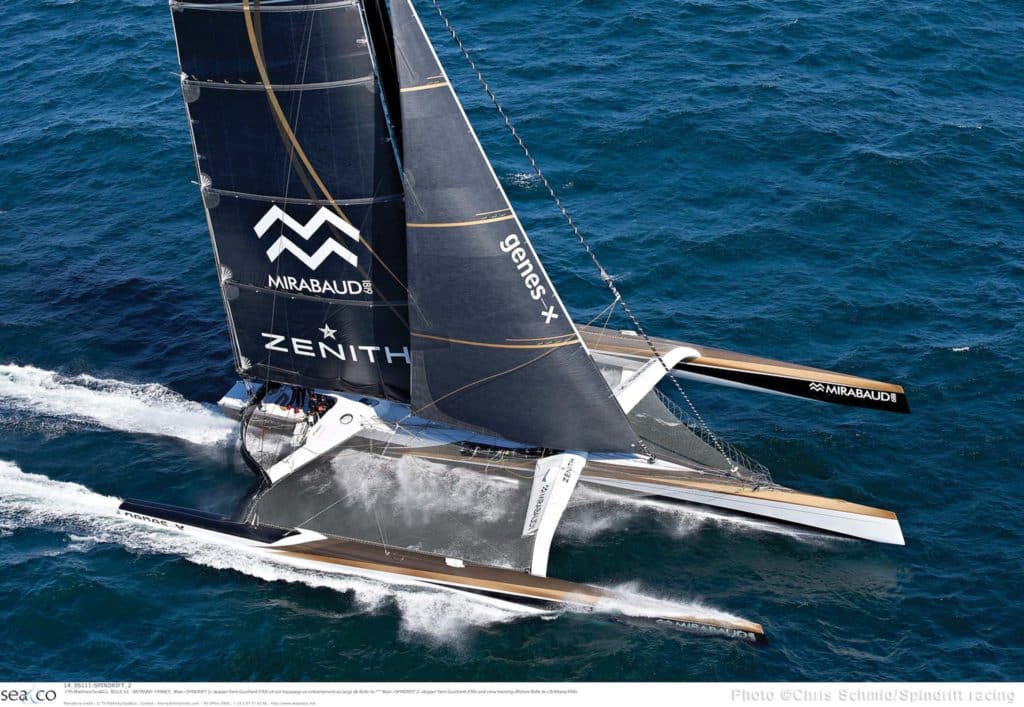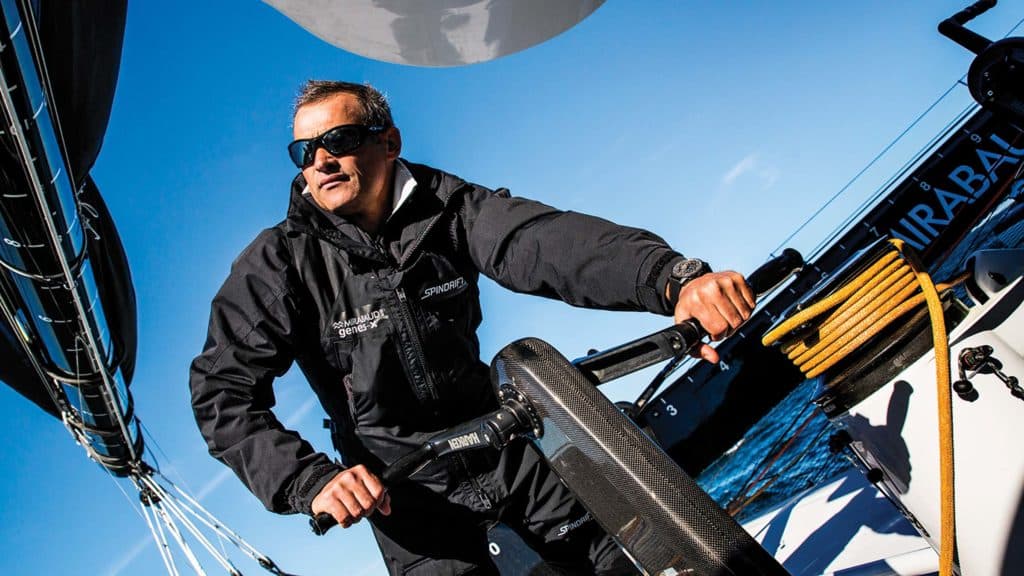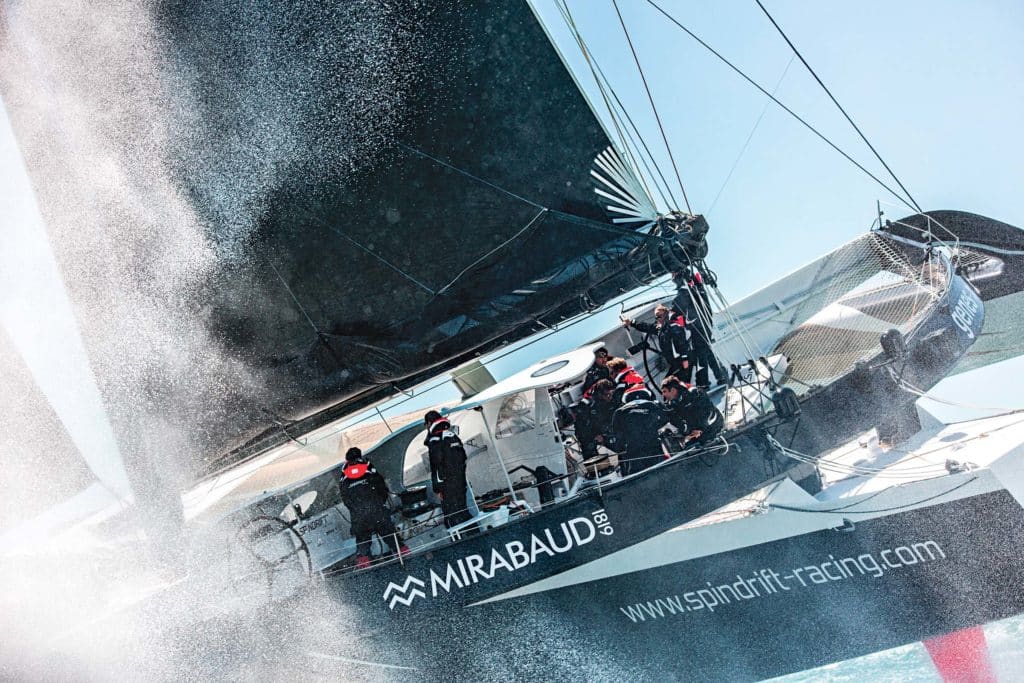Three days, 15 hours, 25 minutes, from New York’s Ambrose Lighthouse to Lizard Point on southwest coast of England. Imagine it. That’s the crewed transatlantic record of Banque Populaire V, the benchmark since 2009. At the time, it was unfathomable to think the record could ever be eclipsed without a breakthrough design: maybe a foiling or wing-powered craft.
To get near this amazing three-day barrier, let alone surpass it, requires precision in so many ways: planning and boat development, absolutely perfect weather conditions, and more than anything else, luck. Lucky that nothing critical breaks, lucky the forecast is accurate all the way to England, lucky that a single, and potentially fatal, semi-submerged object isn’t lurking in one’s path. There are plenty deal breakers: logs, icebergs, sea life, shipping containers, fishing nets, and any anything else that could make them stop or veer a few degrees off course.
“There’s no margin,” says Yann Guichard, the decorated multihull sailor from France, as we discuss the team’s record attempt from inside the cavernous nav station of the 131-foot trimaran Spindrift 2. Guichard, his companion and co-skipper Dona Bertarelli, of Switzerland, and a crew of 10 recently arrived from France. They will berth the 65-foot-wide boat at the Newport Shipyard and wait for the atmosphere’s highs and lows to align ever so perfectly. If the right weather pattern doesn’t materialize by August, they’ll try anyway because Guichard will race Spindrift 2 in the Route du Rhum—alone—in November. Then there’s the ultimate mission: the 45-day Jules Verne Trophy.
I join them in Newport to hear about their North Atlantic record attempt, and the natural question is how much time Banque Populaire left on the table. Are we talking seconds or hours, or days?
“For the last 12 hours they had less wind and went slow,” says Bertarelli, standing on the robust bow of the center hull, dwarfed by a roller-furling gennaker, its drum larger than her waist. “How much did they leave? Twelve hours.”
Every minute of the attempt must be accounted for, says Guichard, as he explains how they’ve modified the very same boat whose record they intend to beat. During a yearlong refit they stripped out 2 tons and lobbed 20 feet off the mast. They’ll leave behind the port daggerboard, and cant the mast to weather to a pre-set angle (they removed hydraulics that once allowed mast cant on demand). If it weren’t for getting to New York to start the attempt, they’d leave the port rudder behind, too, because once they go they can’t afford a single tack or jibe.
“It’s a one-leg run,” says Bertarelli, who is the least experienced crewmember, but an integral part of team (she also manages Spindrift’s 30 employees). “If we need to maneuver, we’re done.”
As I stand at the port-side wheel, it’s impossible to imagine driving this monstrosity across any stretch of water, let alone the berg-ridden Great Circle Route. Even while standing on the platform riser, the bows are invisible. Three large displays are 20 feet away, mounted on the backside of the forward beam, showing speed, course over ground, and apparent windspeed, but when the boat careens across the sea at 40-plus knots, the computers can hardly keep up.
I wish I could experience it, even if for a few minutes, but instead, I’ll have to rely on Bertarelli’s account. “When you pass 35 knots, it’s like driving a Formula 1,” she says, glancing at her partner. “Your movements have to be very precise—an inch of wheel movement is three degrees.”
Bertarelli admits she’s not brave enough to drive at high speeds in the dark. “It’s impossible for me to helm blind—you don’t see the gusts coming, or the waves, you can only rely on the instruments.” They will take 10 or 12 crew, depending on the forecast and how many changes they’ll need to made to the sail plan. Ten must be excellent helmsmen. Maximum time on the wheel is an hour. “Even if you’re not tired you come off,” says Bertarelli. “Your attention is lower and you have a tendency to take more risk because you get used to the speed. When there are waves, I can’t go more than 10 minutes because after that I have no more arm strength.”
If the Spindrift camp is to be successful, there can’t be any waves to begin with, says Guichard. The sea must be absolutely flat in order for them to efficiently devour miles in the early stages.
And so, as I write, they wait, confident they’ve assembled a team capable of beating the most challenging records in the sport. They’ve got the biggest, fastest multihull on the planet, so while there’s certainly danger there’s no second guessing in this camp. “We’re not crazy,” says Bertarelli. “We’re serious about what we do and how we do it.”
This article first appeared in the July/August 2014 issue of Sailing World. Click here to read more from editor Dave Reed.












